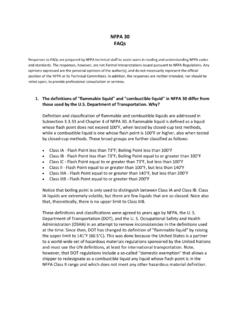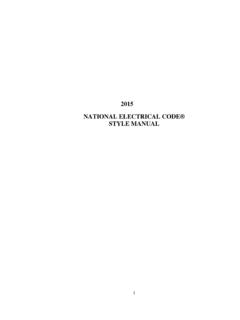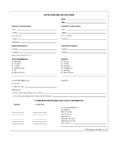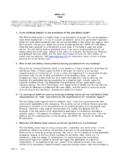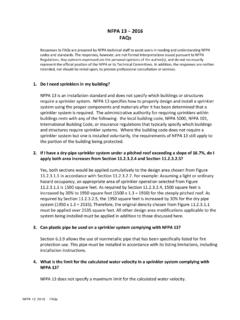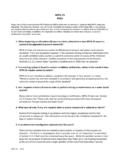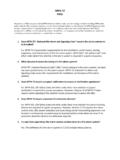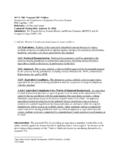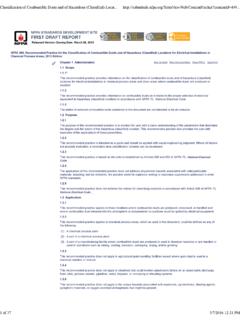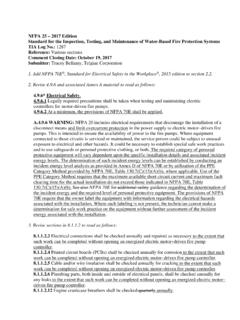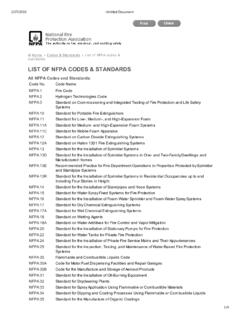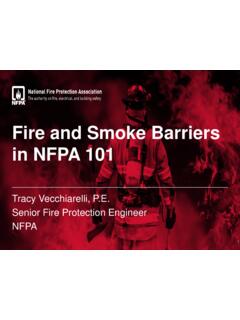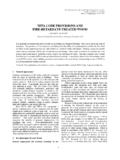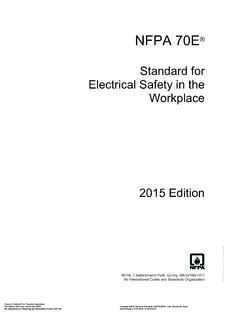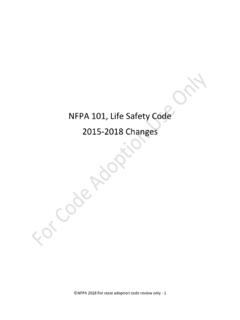Transcription of NFPA 101-2012 Life Safety Code TIA Log No.: 1075 Reference ...
1 1 nfpa 101-2012 Life Safety Code TIA Log No.: 1075 Reference : (11) (12), (11) (13), related and alarm system provisions, and associated advisory annex Comment Closing Date: October 4, 2012 Submitter: Thomas Jaeger, Jaeger and Associates, LLC 1. Revise (11) (12), (11) (13), related and alarm system provisions, and associated advisory annex as follows: Chapter 18 New Health Care Occupancies Chapter 19 Existing Health Care Occupancies * Within a smoke compartment, where residential or commercial cooking equipment is used to prepare meals for 30 or fewer persons, one cooking facility shall be permitted to be open to the corridor, provided that all of the following conditions are met: (1) The portion of the health care facility served by the cooking facility is limited to 30 beds and is separated from other portions of the health care facility by a smoke barrier constructed in accordance with , , and (2) The cooktop or range is equipped with a range hood of a width at least equal to the width of the cooking surface, with grease baffles or other grease-collecting and clean-out capability.
2 (3)* The hood systems have a minimum airflow of 500 cfm (14,000 L/min). (4) The hood systems that are not ducted to the exterior additionally have a charcoal filter to remove smoke and odor. (5) The cooktop or range complies with all of the following: (a) The cooktop or range is protected with a fire suppression system listed in accordance with UL 300, Standard for Fire Testing of Fire Extinguishing Systems for Protection of Commercial Cooking Equipment, or is tested and meets all requirements of UL 300A, Extinguishing System Units for Residential Range Top Cooking Surfaces, in accordance with the applicable testing document's scope. (b) A manual release of the extinguishing system is provided in accordance with nfpa 96, Standard for Ventilation Control and Fire Protection of Commercial Cooking Operations, Section (c) An interlock is provided to turn off all sources of fuel and electrical power to the cooktop or range when the suppression system is activated.
3 (6)* The use of solid fuel for cooking is prohibited. (7)* Deep-fat frying is prohibited (8) Portable fire extinguishers in accordance with nfpa 96 are located in all kitchen areas. (9)* A switch meeting all of the following is provided: (a) A locked switch, or a switch located in a restricted location, is provided within the cooking facility that deactivates the cooktop or range. (b) The switch is used to deactivate the cooktop or range whenever the kitchen is not under staff supervision. * Within a smoke compartment, where residential or commercial cooking equipment is used to prepare meals for 30 or fewer persons, one cooking facility shall be permitted to be open to the corridor, provided that all of the following conditions are met: (1) The portion of the health care facility served by the cooking facility is limited to 30 beds and is separated from other portions of the health care facility by a smoke barrier constructed in accordance with , , and (2) The cooktop or range is equipped with a range hood of a width at least equal to the width of the cooking surface, with grease baffles or other grease-collecting and clean-out capability.
4 (3)* The hood systems have a minimum airflow of 500 cfm (14,000 L/min). (4) The hood systems that are not ducted to the exterior additionally have a charcoal filter to remove smoke and odor. (5) The cooktop or range complies with all of the following: (a) The cooktop or range is protected with a fire suppression system listed in accordance with UL 300, Standard for Fire Testing of Fire Extinguishing Systems for Protection of Commercial Cooking Equipment, or is tested and meets all requirements of UL 300A, Extinguishing System Units for Residential Range Top Cooking Surfaces, in accordance with the applicable testing document's scope. (b) A manual release of the extinguishing system is provided in accordance with nfpa 96, Standard for Ventilation Control and Fire Protection of Commercial Cooking Operations, Section (c) An interlock is provided to turn off all sources of fuel and electrical power to the cooktop or range when the suppression system is activated.
5 (6)* The use of solid fuel for cooking is prohibited. (7)* Deep-fat frying is prohibited. (8) Portable fire extinguishers in accordance with nfpa 96 are located in all kitchen areas. (9)* A switch meeting all of the following is provided: (a) A locked switch, or a switch located in a restricted location, is provided within the cooking facility that deactivates the cooktop or range. (b) The switch is used to deactivate the cooktop or range whenever the kitchen is not under staff supervision. 2 (c) The switch is on a timer, not exceeding a 120-minute capacity, that automatically deactivates the cooktop or range, independent of staff action. (10) Procedures for the use, inspection, testing, and maintenance of the cooking equipment are in accordance with Chapter 11 of nfpa 96 and the manufacturer s instructions and are followed. (11)* Not less than two AC-powered photoelectric smoke alarms with battery backup, interconnected in accordance with , and equipped with a silence feature, and in accordance with nfpa 72, National Fire Alarm and Signaling Code, are located not closer than 20 ft ( m) and not further than 25 ft ( m) from the cooktop or range.
6 (12)* The smoke alarms required by (11) are permitted to be located outside the kitchen area where such placement is necessary for compliance with the 20-ft ( ) minimum distance criterion. (13)* A single system smoke detector is permitted to be installed in lieu of the smoke alarms required in (11) provided the following criteria are met: (a) The detector is located not closer than 20 ft ( m) and not further than 25 ft ( m) from the cooktop or range. (b) The detector is permitted to initiate a local audible alarm signal only. (c) The detector is not required to initiate a building-wide occupant notification signal. (d) The detector is not required to notify the emergency forces. (e) The local audible signal initiated by the detector is permitted to be silenced and reset by a button on the detector or by a switch installed within 10 ft ( m) of the system smoke detector. (14) (12) No System smoke detectors is located less than 20 ft ( m) from the cooktop or range that are required to be installed in corridors or spaces open to the corridor by other sections of this chapter are not used to meet the requirements of (11) and are located not closer than 25 ft ( m) to the cooktop or range.
7 _____ Initiation of the required fire alarm systems shall be by manual means in accordance with and by means of any required sprinkler system waterflow alarms, detection devices, or detection systems, unless otherwise permitted by and _____ The system smoke detector installed in accordance with (13) shall not be required to initiate the fire alarm system. _____ (c) The switch is on a timer, not exceeding a 120-minute capacity, that automatically deactivates the cooktop or range, independent of staff action. (10) Procedures for the use, inspection, testing, and maintenance of the cooking equipment are in accordance with Chapter 11 of nfpa 96 and the manufacturer s instructions and are followed. (11)* Not less than two AC-powered photoelectric smoke alarms with battery backup, interconnected in accordance with , and equipped with a silence feature, and in accordance with nfpa 72, National Fire Alarm and Signaling Code, are located not closer than 20 ft ( m) and not further than 25 ft ( m) from the cooktop or range.
8 (12)* The smoke alarms required by (11) are permitted to be located outside the kitchen area where such placement is necessary for compliance with the 20-ft ( ) minimum distance criterion. (13)* A single system smoke detector is permitted to be installed in lieu of the smoke alarms required in (11) provided the following criteria are met: (a) The detector is located not closer than 20 ft ( m) and not further than 25 ft ( m) from the cooktop or range. (b) The detector is permitted to initiate a local audible alarm signal only. (c) The detector is not required to initiate a building-wide occupant notification signal. (d) The detector is not required to notify the emergency forces. (e) The local audible signal initiated by the detector is permitted to be silenced and reset by a button on the detector or by a switch installed within 10 ft ( m) of the system smoke detector. (14) (12) No System smoke detectors is located less than 20 ft ( m) from the cooktop or range that are required to be installed in corridors or spaces open to the corridor by other sections of this chapter are not used to meet the requirements of (11) and are located not closer than 25 ft ( m) to the cooktop or range.
9 (15) (13) The smoke compartment is protected throughout by an approved, supervised automatic sprinkler system in accordance with Section _____ Initiation of the required fire alarm systems shall be by manual means in accordance with and by means of any required sprinkler system waterflow alarms, detection devices, or detection systems, unless otherwise permitted by through _____ The system smoke detector installed in accordance with (13) shall not be required to initiate the fire alarm system. Fixed extinguishing systems protecting commercial cooking equipment in kitchens that are protected by a complete automatic sprinkler system shall not be required to initiate the fire alarm 3 Occupant Notification. Occupant notification shall be accomplished automatically in accordance with , unless otherwise modified by the following: (1) Paragraph shall not be permitted to be used. (2)*In lieu of audible alarm signals, visible alarm-indicating appliances shall be permitted to be used in critical care areas.
10 (3) The provision of (13)(c) shall be permitted to be used. Fire department Emergency forces notification shall be accomplished in accordance with , except that the provision of (13)(d) shall be permitted to be used. _____ The intent of is to limit the number of persons for whom meals are routinely prepared to not more than 30. Staff and feeding assistants are not included in this number. (3) The minimum airflow of 500 cfm (14,000 L/m) is intended to require the use of residential hood equipment at the higher end of equipment capacities. It is also intended to draw a sufficient amount of the cooking vapors into the grease baffle and filter system to reduce migration beyond the hood. (6) The intent of this provision is to limit cooking fuel to gas or electricity. The prohibition of solid fuels for cooking is not intended to prohibit charcoal grilling on grills located outside the facility. (7) Deep-fat frying is defined as a cooking method that involves fully immersing food in hot oil.
